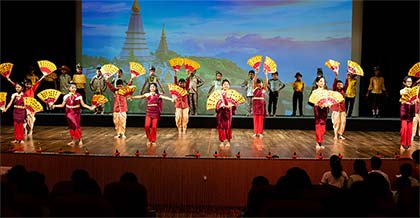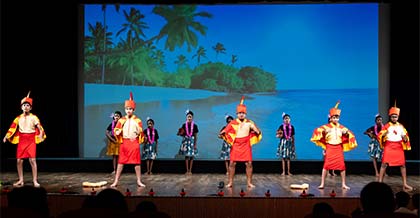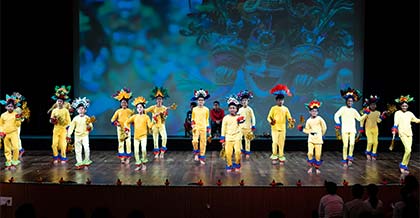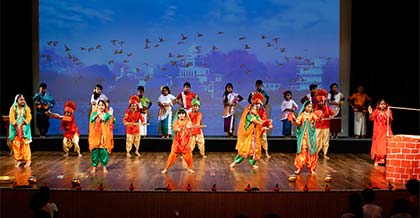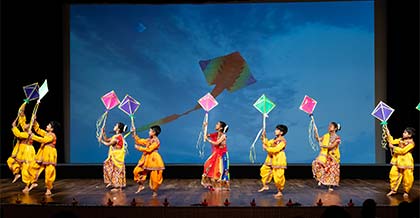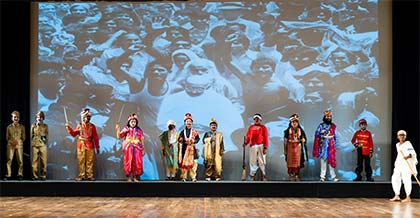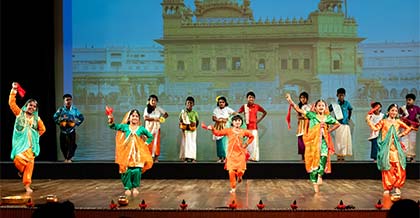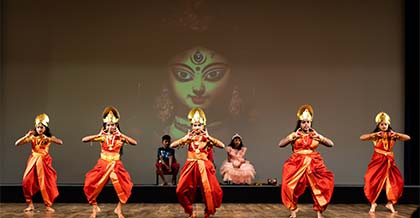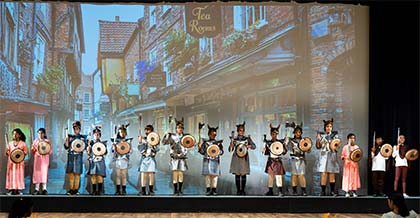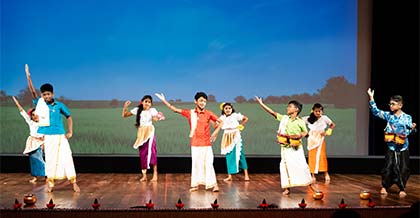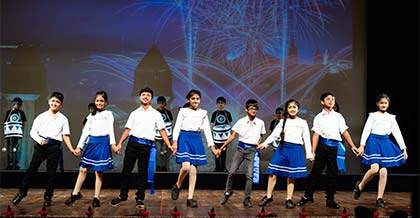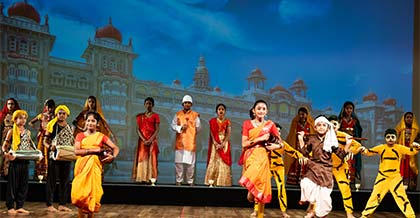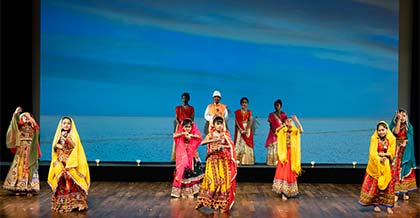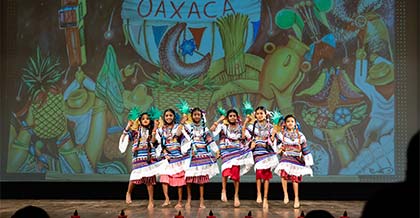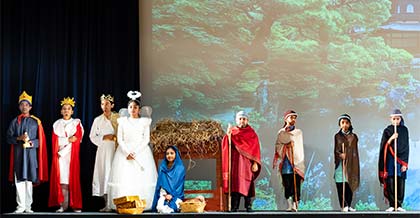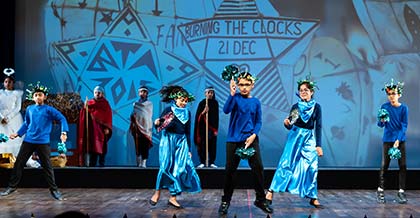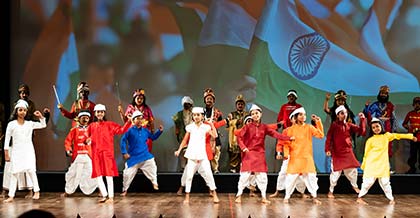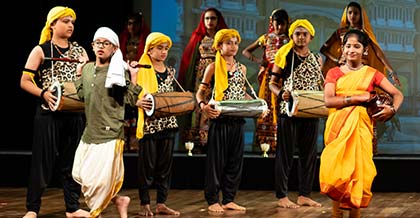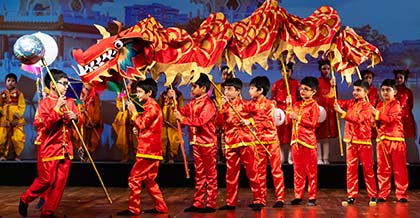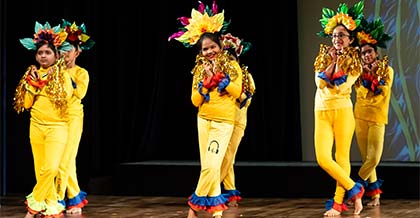Utsaham - Grades 3-5
NPS International Chennai’s Annual Cultural Day, Utsaham 2023, was celebrated on Saturday, 11th February 2023. The afternoon event, “Around the World in a Year”, involved students of Grades 3, 4, and 5 presenting local traditions and popular festivals not only from locations all around the world but also through the period spanning one calendar year, beginning in January and ending in December. Parents and other guests were seated in the school auditorium by 4:15 PM, and the dignitaries made their entrance at 4:30 PM. The Chief Guest for the afternoon session was Shrimati Dhivya Srilakshmi, a dancer with over 18 years’ experience and founder of “Prakritilaya Academy of Arts”, as well as being a Doordarshan artist and yoga practitioner and trainer.
The programme began with an introduction to the theme and the idea that communities all around the world had significant dates commemorated with music, dance, food and festivity. Before each class came on stage, the narrators shared some information on how the month was viewed across the world and listed a few celebrations from different places. During the presentations, nuggets of information about the festival or celebration were shared, explaining the significance of costumes, foods or dances. The background for each performance reflected the unique culture which was being represented, giving an immersive experience for the audience.
Students of Grade 3A began with the month of January and the International Kite Festival of India, also called Uttarayan. This was followed by a depiction of Chinese New Year with characteristic red lanterns and featuring a dragon puppet carried by students. February was presented by Grade 3A. Children performed two dances from Jamaica, kumina and quadrille, Next came the Chiang Mai Flower Festival of Thailand, depicted through a graceful and beautiful fan dance. Grade 3C began with a presentation of Holi to celebrate March. Aspects of the celebration were shown on stage, from throwing coloured powders to spraying friends and family with water. This was followed by the Stricha Spring Festival of Ukraine depicting spring dances. April was taken on by Grade 3D who captured the Sri Lankan New Year followed by the Punjabi celebration of Baisakhi. Grade 4C capably represented the month of May, recreating Viking History in honour of Viking Day, followed by a graceful dance celebrating Hidirellez, or the Turkish Spring Festival. June was depicted by Grade 4A, beginning with a beautiful depiction of the Saga Dawa Festival of Sikkim followed by a dance marking the Strawberry Festival of Rome.
Grade 4D took on the Guelaguetza Festival of Mexico celebrated in July. They presented six of more than twenty local dances to the audience, ably capturing the unique style of each one. The month of August was of course dedicated to Indian Independence. Grade 4B captured the essence of Indian patriotism, revolution and freedom in their recreation of important moments in our history and recollection of individuals whose sacrifices led us to victory. September was presented by Grade 5D, beginning with a recreation of Aloha Festivals in Hawai’i and ending with the Catalonian festival of La Mercè in Spain. Grade 5C used the backdrop of the Mumbai Arts Festival to showcase some interesting events of October, travelling to the Philippines to witness the MassKara Festival, depicting Durga Puja and Dussehra in India and ending with the Albuquerque International Balloon Fiesta in USA.
November was presented by Grade 5B with several different events. They began with an acknowledgement of Children’s Day on November 14 which was followed by traditional dances from Gujarat to celebrate the beginning of the Rann Utsav festival. Next came four traditional dances in honour of November 1st, celebrated as Kannada Rajyotsava Day in Karnataka – Dollu Kunitha, Hulivesha, traditional folk dance and Yakshagana. Finally the month ended with a celebration of the festival of lights – Diwali. The month of December began with the nativity scene of the infant Jesus with the wise men and shepherds. This was followed by the Chichibu Night Festival in Japan, the “Burning the Clocks” Festival in England and finally the Hornbill Dance Festival of Nagaland, representing culture from all ethnic groups of Nagaland.
Each depiction had carefully designed costumes, props and background visuals and was set to musical selections curated from the region. The enthusiastic reactions of the audience added to the power of the performances. They clapped along to the beat for all the dances and cheered for each depiction of cultural specificity. The fierce Viking and Hawai’ian warriors were cheered on, as were all characters in the depiction of India’s fight for independence. The compelling story of Thirupoor Kumaran, who gave his life to protect the Indian flag, resonated powerfully with the members of the audience. The graceful dances from places like Gujarat, Nagaland, Sri Lanka, China, Japan, Thailand, Turkey and Hawai’i were cheered on with the same enthusiasm as the vigorous dances from Mexico, Punjab, Spain, Italy and Phillipines.
Once the presentation of December came to an end, the Chief Guest was invited on stage to address the gathering. Shrimati Dhivya Srilakshmi shared effusive praise for the show, beginning with a request for a standing ovation. She was appreciative of the thought behind the theme of the event, taking the audience around the world and through a full year in the span of less than two hours. She acknowledged the depth of research needed to accurately present the wide range of events and festivals and enjoyed learning about them. She admired the work put in by teachers on costumes and props, pointing out their ingenuity and cost-effectiveness. She finished with a note about the accuracy of the steps which truly represented the various dance forms.
The closing remarks were made by Principal of NPS International Chennai, Ms. Sudha Balan. She began by thanking the Chief Guest for her words and echoing her sentiments about the event. She praised the young performers on stage for their passion and hard work, complimenting the young ones on their stagecraft, ably adapting to cues and positions. She appreciated the hard work of all the teachers, who had spent months of time in research and brainstorming for the complex event while taking on multiple other responsibilities. She added that each theme presented by NPSI had a component of education and learning which was important to the school. She pointed out that 36 unique dances had been performed on stage and each aspect had to be authentic and appropriate, from music and dance steps to background images and lighting. Specific teachers and teams were thanked, including senior student narrators and volunteers who were brought on stage. She concluded her remarks by thanking parents and grandparents for their support and partnership and hoped for a relationship which could last for generations. The event concluded with a rendition of the national anthem.






















